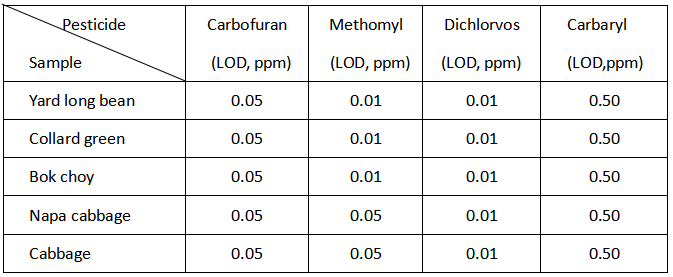FSTest Pesticide Test Card(Ultra) – Fast, Simple, and Portable Detection of Organophosphate & Carbamate Residues
Product Overview
Pesticide residues—especially organophosphates (OP) and carbamates (CM)—are a growing concern in food safety. These toxic compounds can remain on fresh produce, posing significant health risks to consumers.
The FSTest Pesticide Test Card offers a paper-based, rapid pesticide screening tool that uses enzyme inhibition to detect OP and CM pesticide residues with high sensitivity and accuracy. The test is based on the inhibition of acetylcholinesterase (AChE) activity, a proven method in pesticide detection.
When pesticide residues are present, they inhibit AChE, preventing the hydrolysis of indoxyl acetate, thus reducing or eliminating the formation of the blue color on the test strip. The deeper the blue, the safer the sample.
Key Features
✅ Rapid Results: Get results in as little as 15 minutes—ideal for on-the-spot testing.
✅ User-Friendly: Simple operation, no lab equipment or technical background needed.
✅ Clear Visual Interpretation: Color intensity directly reflects pesticide levels—easy to read.
✅ Cost-Effective: Affordable testing for everyday consumers, growers, or inspectors.
✅ Compact & Portable: Lightweight and convenient for on-site use, even in remote areas.
✅ Original Manufacturer: Backed by 30+ years of R&D experience since 1993.
Kit Contents
20 × Pesticide Test Cards
2 × Plastic dropers
1 × User Manual
Shelf Life: 12 months
Storage: Cool, dry place
Applications
Designed for rapid pesticide residue detection in:
✅ Fresh fruits and vegetables
✅ Leafy greens and root crops
✅ Tea leaves and herbs
✅ Agricultural produce and food markets
Recommended For
✅ Home users / health-conscious consumers
✅ Supermarkets & fresh produce sections
✅ Farmers, growers, and distributors
✅ Import/export inspection teams
✅ Food safety inspection and quarantine bureaus
How It Works: The Science Behind the Test
The test detects the inhibition of acetylcholinesterase (AChE) by OP/CM pesticides:
No pesticide → AChE breaks down indoxyl acetate → Produces blue color
With pesticide → AChE activity is inhibited → Little to no blue color appears
The lighter the blue, the higher the pesticide residue.
3 Easy Testing Steps
1️⃣ Sample Preparation
Choose one of three methods:
Surface Sampling: Apply buffer to sample surface, rub with another leaf to extract juice.
Fragment Sampling: Cut 5g of produce, mix with 10mL buffer, shake 50 times, let stand 2 mins.
Whole Sampling (recommended for high-chlorophyll produce like tomato, leek, etc.): Same as fragment, but use whole cleaned produce.
2️⃣ Incubation
Take two test cards (A & B).
Add 80μL sample solution to Strip A and 80μL buffer to Strip B (control).
Incubate with PR300 Portable PestiCheck Incubator or let sit at room temperature for 10 mins.
3️⃣ Reaction & Interpretation
Fold both strips at the center and press them together for 3 mins.
Compare color intensity in test zones:
Deep Blue = No pesticide detected
Faint or No Blue = Possible pesticide residue present
Note: Always use control strip (B) as a color reference.
Why Test for Pesticide Residues?
✔ Protect your family from chemical exposure
✔ Monitor produce quality in real time
✔ Ensure food safety in local markets
✔ Comply with regulatory standards for exports
Why Choose FSTest?
✔ Established in 1993 – Trusted by professionals across agriculture, testing, and government sectors
✔ Highly Sensitive – Detects low levels of OP and CM residues
✔ Affordable & Accessible – Ideal for both professionals and everyday users
✔ Visual Results – No readers, batteries, or instruments required
Chiang Mai University – Validation Data Summary

With the FSTest Pesticide Test Card-Ultra, food safety is just a few drops away. Whether you're a consumer looking to protect your health or a professional needing field-ready tools, FSTest makes pesticide detection simple, fast, and effective.













